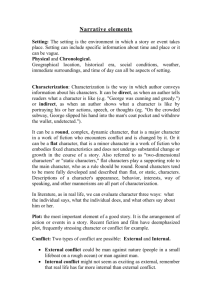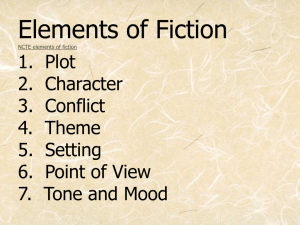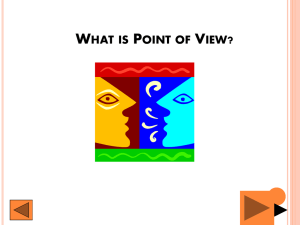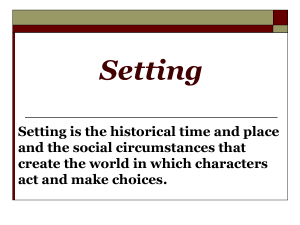Point of View
advertisement
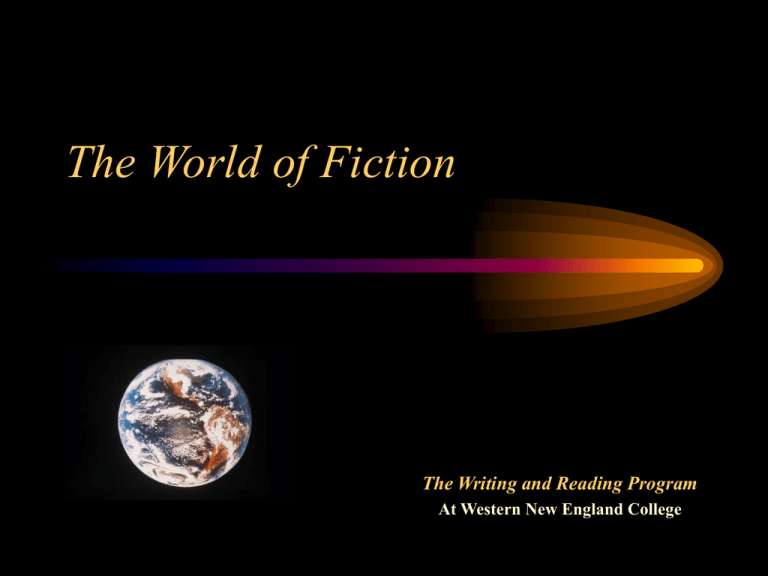
The World of Fiction The Writing and Reading Program At Western New England College Definition • The world of fiction is the world of the imagined. Although authors sometimes draw on their experiences and even certain periods in history when they write, fiction tells an invented story using prose. Hallmarks of Fiction • Realistic characters • Human experiences • Identifiable setting Key Terms • Characters – In any story, the characters support the plot. – The main character is often called the protagonist. – Dialogue (including diction), actions, gestures, and appearance are all keys to understanding character. – The term “characterization” refers to the way the author reveals and develops characters. Key Terms • Setting – The geographical, historical, and social location of the story refers to its setting. – Setting tells the reader a great deal about tone and overall purpose. Key Terms • Tone – The mood of a story is often referred to as the tone. Tone is conveyed by: Sentence structure Diction Key Terms Point of View • The phrase “point of view” refers to the person or persons telling the story or relating the ideas. First Person – If the story is told in the “first person,” the narrator will use the pronouns “I,” and / or “we” to convey information. Of course, the first person narrator’s perspective is limited. “In walks these three girls in nothing but bathing suits. I’m in the third check-out slot, with my back to the door, so I don’t see them until they’re over by the bread.” “A&P” John Updike Problems with First Person • What are some of the limitations of the first person narrator? First person narrators interject their own idiosyncratic view of the world. They may have a severely limited perspective. Third Person – Another common point of view is the third person (he, she, it, or they). There are three basic approaches to using this perspective: • Omniscient • Limited Omniscient • Objective Omniscient Point of View – The third person “omniscient” narrator understands the full significance of the action. This “all-knowing” narrator even understands the thoughts and feelings of the characters. “In a house, in a suburb, in a city, there were a man and his wife who loved each other very much […].” Nadine Gordimer, “Once Upon a Time” Limited Omniscient • A narrator who knows the thoughts, feelings and motivations of one character is said to have “limited omniscience.” “They were the same woods, she thought sleepily as they drove through the early morning darkness – deep and immense, covered with yesterday’s snowfall, which had frozen overnight.” “Doe Season” by David Michael Kaplan Objective Point of View • Often called the “dramatic viewpoint,” objective narrators tell the story without delving into the thoughts or feelings of the characters. • The objective point of view relates dialogue and reports action and events without adding interpretations. Objective Point of View • “A girl and a soldier went by in the street. The street light shone on the brass number on his collar. The girl wore no head covering and hurried beside him.” “A Clean, Well-Lighted Place” E. Hemingway Key Terms • Plot – the events of the story that make a cohesive whole – A flashback is a return to an earlier time. – Foreshadowing provides a hint of something to come. Theme • The central or main idea of a work is its theme. The following elements can provide clues about the theme: – – – – – – Title Setting Point of View Characters Plot and Conflict Use of symbolism • The stories and novels you read combine elements with endless variations. • Enjoy learning about the world and yourself as you experience great authors of fiction.

